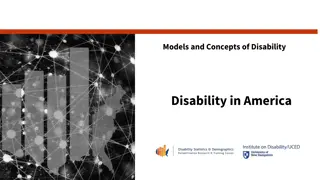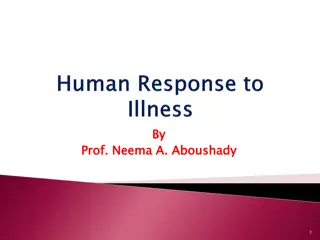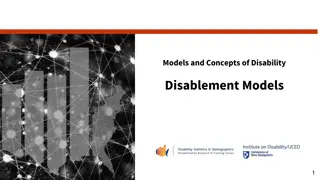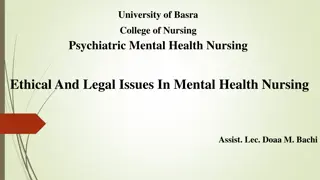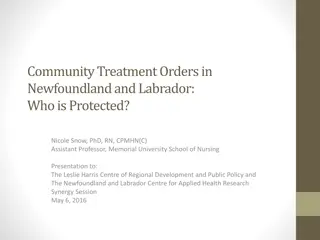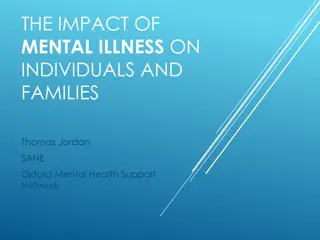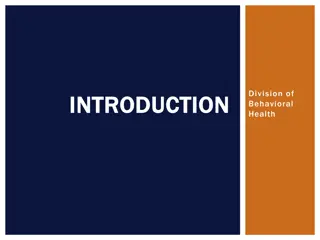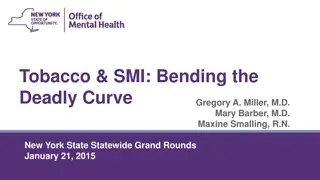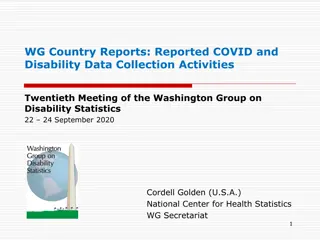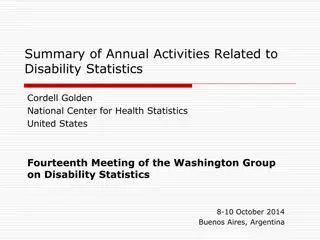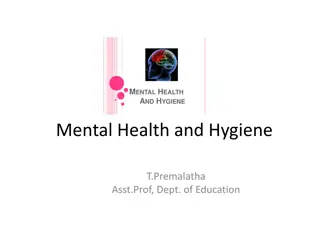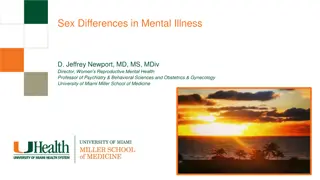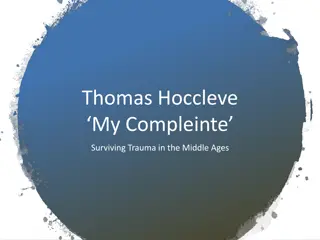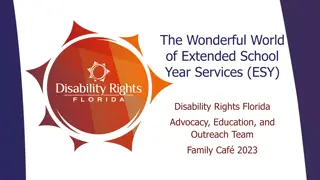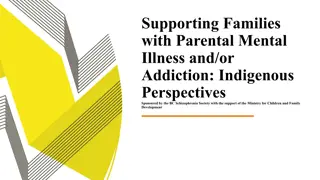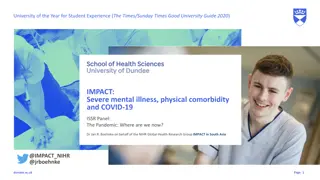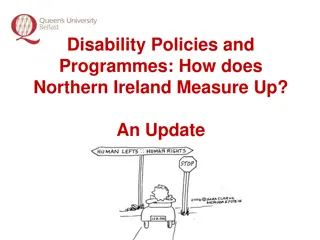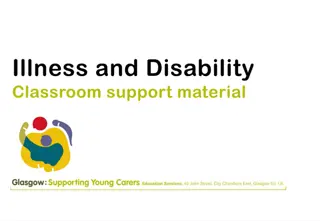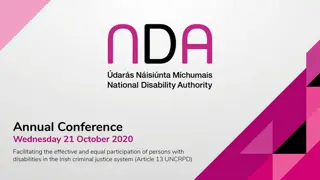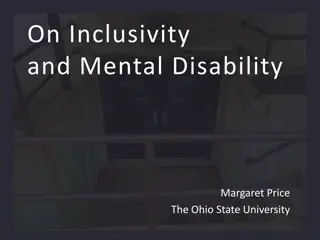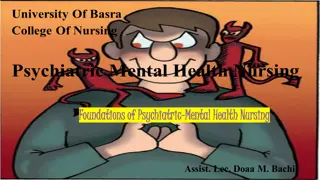Understanding Mental Illness and Disability Rights
This content provides insights into commonly held attitudes and beliefs about mental illness, the American with Disabilities Act of 1990, definitions of mental illness per NRS 433A.115, and interactions with individuals with mental health issues. It also covers misconceptions, the 72-hour hold for mental illness, and the ADA's impact on preventing discrimination based on disability.
Download Presentation

Please find below an Image/Link to download the presentation.
The content on the website is provided AS IS for your information and personal use only. It may not be sold, licensed, or shared on other websites without obtaining consent from the author. Download presentation by click this link. If you encounter any issues during the download, it is possible that the publisher has removed the file from their server.
E N D
Presentation Transcript
Identify commonly held attitudes and beliefs about people with mental illness. State the intent of the American with Disabilities Act of 1990 as it refers to law enforcement. Define person with mental illness per NRS 433A.115. Recognize differences between mental illness, developmental disability and neurological disorders. Recognize behaviors of and ways to interact with mental illness, to include: Assessing unpredictable and dangerous behavior and maintain the safety of all people involved, to include: I. Suicide. II. Suicide by cop. Gathering information so that appropriate dispositions may be chosen. Identify the elements of the 72 hour hold concerning mental illness (NRS 433A.150) A. B. C. D. E. 1. 2. F.
1. Mental health problems do not affect children or youth. Any problems they have are just part of growing up. 2. It is the parents fault if children suffer from mental health problems. . 3. People with a mental illness are psycho , mad and dangerous, and should be locked away. 4. All people with Schizophrenia are violent. 5. Depression is a character flaw and people should just snap out of it .
6. Addiction is a lifestyle choice and shows a lack of willpower. 7. Electroconvulsive therapy (ECT), also known as shock therapy, is painful and barbaric. 8. People with a mental illness lack intelligence. 9. People with a mental illness shouldn t work because they ll just drag down the rest of the staff. 10. Mental illness is a single, rare disorder. 11. People with a mental illness never get better.
ADA was signed into law in 1990 by President George H.W. Bush. This law prohibits discrimination based on disability.
The definition of disability is comprised of three criteria of which an individual only has to meet one criteria . has a physical or mental impairment that substantially limits one or more major life activities; or has a history or record of a physical or mental impairment that substantially limited one or more major life activities; or is regarded as having an impairment, whether the person has the impairment or not https://www.adaactionguide.org/ada-title-ii-requirements#whoisprotected 1. 2. 3.
The language of Title II of the Americans with Disabilities Act (ADA) is succinct: [N]o qualified individual with a disability shall, by reason of such disability, be excluded from participation in or be denied the benefits of the services, programs, or activities of a public entity, or be subjected to discrimination by any such entity. (https://www.prisonlegalnews.org/news/2013/sep/15/the- americans-with-disabilities-act-and-prisoners/)
After being sentenced to 18 to 36 months in prison, Ronald Yeskey was recommended as a candidate for a Motivational Boot Camp for first-time offenders. Successful completion of the Boot Camp could have resulted in Yeskey's early parole after just six months. When the Pennsylvania Department of Corrections discovered Yeskey's medical history of hypertension, he was denied admission to the Boot Camp. Yeskey challenged the refusal as discriminatory. On appeal from a reversal of a district court's dismissal of the claim, the Supreme Court granted certiorari.
In Pennsylvania DOC v. Yeskey, 524 U.S. 206 (1998) [PLN, Sept. 1998, p.1], the Supreme Court held that the ADA applies to people in prison. Title II of the ADA defines public entity to include any department, agency, special purpose district, or other instrumentality of a State or States or local government. 42 U.S.C. 12131(1)(B). In Yeskey, Justice Scalia wrote, The text of the ADA provides no basis for distinguishing these programs, services, and activities from those provided by public entities that are not prisons. Thus, Title II of the ADA extends to prisoners. https://www.prisonlegalnews.org/news/2013/sep/15/the-americans- with-disabilities-act-and-prisoners/
Investigation started Dec 2011 under the Civil Rights of Institutionalized Persons Act (CRIPA) and also involved findings under the ADA. May 2013 DOJ issued results of investigation. Use of solitary confinement (long and short term) violates the ADA and 8thAmendment Rights of inmates with chronic and acute mental illness, many of whom also have intellectual disabilities. These inmates were locked down for 22-23 hours a day for months or years, denied basic necessities, and subjected to harsh and punitive conditions including excessive use of force.
Solitary confinement was used as a means of warehousing mentally ill inmates. Mental Health staff were marginalized. Inconsistent and unorganized programs. Disciplinary system that punished disability- related behaviors. Psychotic prisoners being placed in solitary confinement. Risk assessments were not done on inmates, e.g. past history of suicides.
Roy Austin, Deputy Assistant Attorney General for the DOJ s Civil Rights Division, stated, We found that Cresson often permitted its prisoners with serious mental illness or intellectual disabilities to simply languish, decompensate, and harm themselves in solitary confinement for months or years on end under harsh conditions in violation of the Constitution. These practices have serious public safety consequences because many of these individuals are [eventually] returned to the community. (https://www.prisonlegalnews.org/news/2013/sep/15/the-americans- with-disabilities-act-and-prisoners/)
Title II applies to state and local governments including state executive agencies, courts, legislatures, towns, cities, counties, school districts, universities, community colleges, water districts, special purpose districts, regional transit authorities, other state and local government instrumentalities and AMTRAK. (https://www.adaactionguide.org/ada-title-ii-requirements#whoisprotected) Please see AR 658 as Title I, II, and III apply and are clearly delineated in AR 658.
1. unless the context otherwise requires, person with mental illness means any person whose capacity to exercise self-control, judgment and discretion in the conduct of the person s affairs and social relations or to care for his or her personal needs is diminished, as a result of a mental illness, to the extent that the person presents a clear and present danger of harm to himself or herself or others, but does not include any person in whom that capacity is diminished by epilepsy, intellectual disability, dementia, delirium, brief periods of intoxication caused by alcohol or drugs, or dependence upon or addiction to alcohol or drugs, unless a mental illness that can be diagnosed is also present which contributes to the diminished capacity of the person. As used in NRS 433A.115 to 433A.330, inclusive,
2. if, within the immediately preceding 30 days, the person has, as a result of a mental illness: a) Acted in a manner from which it may reasonably be inferred that, without the care, supervision or continued assistance of others, the person will be unable to satisfy his or her need for nourishment, personal or medical care, shelter, self-protection or safety, and if there exists a reasonable probability that the person s death, serious bodily injury or physical debilitation will occur within the next following 30 days unless he or she is admitted to a mental health facility pursuant to the provisions of NRS 433A.115 to 433A.330, inclusive, and adequate treatment is provided to the person; b) Attempted or threatened to commit suicide or committed acts in furtherance of a threat to commit suicide, and if there exists a reasonable probability that the person will commit suicide unless he or she is admitted to a mental health facility pursuant to the provisions of NRS 433A.115to 433A.330, inclusive, and adequate treatment is provided to the person; or c) Mutilated himself or herself, attempted or threatened to mutilate himself or herself or committed acts in furtherance of a threat to mutilate himself or herself, and if there exists a reasonable probability that he or she will mutilate himself or herself unless the person is admitted to a mental health facility pursuant to the provisions of NRS 433A.115 to 433A.330, inclusive, and adequate treatment is provided to the person. A person presents a clear and present danger of harm to himself or herself
3. harm to others if, within the immediately preceding 30 days, the person has, as a result of a mental illness, inflicted or attempted to inflict serious bodily harm on any other person, or made threats to inflict harm and committed acts in furtherance of those threats, and if there exists a reasonable probability that he or she will do so again unless the person is admitted to a mental health facility pursuant to the provisions of NRS 433A.115 to 433A.330, inclusive, and adequate treatment is provided to him or her. (Added to NRS by 1985, 2268; A 1989, 1757; 1997, 3493; 2009, 333; 2013, 668, 3488) https://www.leg.state.nv.us/NRS/NRS-433A.html#NRS433ASec330 A person presents a clear and present danger of
Mental illness is the reference to all mental disorders involving significant changes in thinking, behavior and/or emotions. Developmental disabilities diverse and chronic conditions due to mental and/or physical impairments. Currently categorized as Neurodevelopmental Disorders on the DSM-5. Neurological disorders are disorders of the central nervous system (brain and spinal cord).
Leading cause of disability in the USA. Knows no barriers affects all walks of life Symptoms may occur often or sporadically and include: Mood Changes Behavior Changes Changes in eating or sleeping patterns These symptoms need to be observed for significant and prolonged changes that are unrelated to current events Most common: Schizophrenia Bipolar Disorder Anxiety Disorders Paranoia Depression
Mentally ill inmates Are not "bad" people, they have an illness. Have real symptoms understand their feelings are genuine Take reinforcement from you! Stay positive and professional it can diffuse potentially bad situations.
Mental disorders occur at high rates in all countries 450 million people worldwide suffer from mental health or behavioral disorders Many disorders are present before incarceration, but others are exacerbated by the stress of prison Prisons are bad for mental health Overcrowding Various forms of violence Lack of privacy Lack of meaningful activity Isolation from social networks Inadequate health services Stigma and discrimination by staff and other prisoners
Officer/staff safety and security is paramount Active listening Brief responses less is best Ask open ended questions (who, what, when, why, how) Avoid yes/no questions Reflect back what you heard Be empathetic Avoid arguing/confrontation Explain procedures always be honest Offer acceptable options Look for voluntary behavioral changes
Inmates with personality disorders want their OWN rules, NOT to play by others' They are impulsive and often act without consideration of consequence Often compulsive liars without guilt They do not learn from experience, and are irresponsible, insisting, and entitled They are energized by and feed off drama, crises, escalation, and can be erratic
Be straightforward and factual Be consistent with enforcing rules Be mindful of attempts to manipulate and compromise When in doubt, contact mental health staff
These are some of the most vulnerable inmates we work with and can be the most behaviorally challenging. At first, inmates with neurodevelopmental disorders may seem normal, or just a little slow. However, signs include: Lack of personal hygiene i.e. forgetting to shower or brush their teeth Difficulty communicating Offenders may not be understood because their thinking is not logical Unusual or inappropriate social behavior/interactions Think things are funny when no one else does or make inappropriate remarks Lack basic life skills i.e. not knowing how to make a collect call Remember, these are SIGNS, not conclusive proof of a neurodevelopmental disorder.
Difficulty functioning in numerous situations, especially new ones. May seem confused and come across as defiant, though they are genuinely having difficulty learning. It is your job to BE ALERT! Take care to not misread this behavior. Remember this is not behavior he can control, it is a result of mental and learning deficits.
Do not give abstract directions "Fill this bucket with water and use the mop to wash the floor" versus "Clean this place up" Give specific and concrete directions Use simple and direct language Use one directive at a time Check to see steps are followed
Used to be called Mental Retardation Begins in early developmental stage with significant limitations in intellectual functioning and adaptive behaviors. This includes problems with: Reasoning Problem solving Planning Abstract thinking Judgement Academic learning Learning from experience Communication Social participation Independent living Across environments, home, work, school, and community
Make sure they get the information they need Give directions slowly and clearly Demonstrate behaviors and activities (if needed) Offer assistance; do not complete tasks for them Protect them from others who might take advantage of them Be understanding Encourage independence
Not adequately assessing suicide threats Not responding to threats or gestures Not developing a treatment/management plan Not adequately monitoring behavior Inadequate response & follow-up Not maintaining adequate records
Suicidal Ideation: thought of ending ones life or of being dead, or wishing death Suicidal Intent: the intent to end one s life Suicide Threat: any action where a juvenile verbally states, writes, or shows by behavior a self-destructive desire, intent, or wish, with or without physical injury Suicide Gestures: an act performed with the apparent intention to cause injury but not death; this may be accompanied by a threat Suicide Attempt: an act apparently intended to end one s life Comorbidity: The presence of more than one diagnosis occurring in an individual at the same time. In psychiatry, comorbidity does not necessarily imply the presence of multiple diseases, but instead can reflect our current inability to supply a single diagnosis that accounts for all symptoms
Suicide is the second leading cause of death in American Jails It is the third leading cause of death in American Prisons The majority of suicides are accomplished through hanging, which causes brain death in 4 minutes, and result in death in 5 or 6 minutes From 2013 to 2014 prison suicide rates increased by 30% Males aged 25 to 34 saw a 50% increase in suicides.
The leading 5 states in prison suicide are California, Texas, New York, Illinois, and Maryland. Nevada tied with 3 other stated for 27th in prison suicides 60 50 40 Prison Suicides Per State 2010 30 20 10 0 CA TX NY IL MD NV
California 448 Inmate suicides Texas 357 Inmate suicides New York 178 Inmate suicides Illinois 102 Inmate suicides Maryland 64 Inmate suicides Nevada 28 Inmate suicides North Dakota ranked the lowest with 1 prison suicide
Psychiatric Illness Co-morbidity Personality Disorder/Traits Neurobiology Impulsiveness Substance Use/Abuse Hopelessness Suicide Severe Medical Illness Family History Access To Weapons Psychodynamics/ Psychological Vulnerability Life Stressors Suicidal Behavior
Any serious mental health disorder, such as schizophrenia and bipolar disorder (comorbidity increases the risk) Previous suicidal behavior or history of family history of suicide attempt Substance use Aggressive/impulsive/violent behavior Major loss of a loved one (death, divorce, or breakup) Interpersonal factors teasing, or lack of perceived social support Legal problems
Severe guilt or shame Perceived low self-worth Recent failure at school or work Feelings of hopelessness / helplessness Lack of future plans Recent rejection by or loss of marriage, family, friends, community Rape or threat of rape Single cell placement Movement to a more restricted program Poor compliance with treatment and/or medication Serious physical illness or chronic pain
The first 24 hours of confinement Intoxication or withdrawal Before or after a court/Board appearance or action During sentencing After count time Holidays and anniversaries of certain events (e.g., family members death) After visitation Impending release After receiving bad news (i.e. death of a loved one, divorce, etc.)
Talking about suicide or wanting to die Discussing ways in which it can be completed Talking about feeling hopeless Talking about feeling trapped Acting agitated or aggressive Behaving recklessly Sleeping too little or too much Not talking to others; not coming out of cell for yard or tier time Displaying extreme mood swings
Expressing excessive guilt or shame over offense Having a history of suicide attempts Expressing hopelessness/helplessness Excessive anxiety Extreme calm after a period of agitation Preoccupation with the past Packs up/gives away belongings Participates in self harming (parasuicidal) behaviors for attention Paranoia
Though any of the previous factors may contribute to suicidal intent, 70% to 80% of all suicides are committed by people who are severely depressed The most common symptoms of depression include: Feelings of inability to continue Extreme sadness and/or crying Social isolation Fluctuations in appetite, weight, and sleep Mood/behavior changes Tension and anxiety Loss of motivation Loss of self esteem Loss of interest Poor hygiene Difficulty concentrating Easily angered or increased agitation
Upon intake, assess suicide risk and imminent suicide risk. Risk status can change over time; staff need to recognize and respond to changes in an inmate s mental condition Information to follow an inmate in case of movement: Previous/current threats Behaviors of depression History of psychiatric care PC or seg status Appropriate observation in isolation cells remember, any segregation increases the risk for suicide!
Low Risk Nonlethal Method No Resource Possible Resource Intact family Family MH History No History of SI No MH issues Some stressors Multiple MH dx/psychosis Moderate Risk Lethal Method Highly Lethal Plan High Risk Resource available Family suicide history Multiple serious attempts 1 or more gestures
OBSERVATION Pay attention to the inmate s speech, attitude, and state of mind. Look for scars from previous attempts. Look for signs of recent trauma. Look for signs of current intoxication or withdrawal.
TAKE ALL THREATS SERIOUSLY! Do not make a judgment call regarding the sincerity of the threat contact medical or mental health staff to assess and make a decision about the necessary intervention.
Offer solutions or give advice Become angry, judgmental, or threatening Act sarcastically or make jokes Placate and make promises Challenge the inmate to follow through on the suicidal threat And above all, DO NOT IGNORE THE THREAT!







